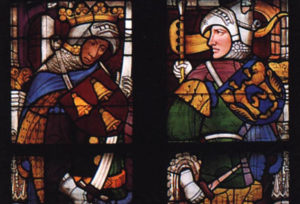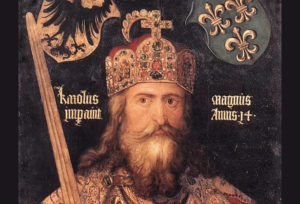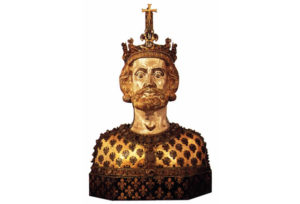Beginnings
 Little is known about Charlemagne’s childhood and the years before he came to the throne. Even his biographer Einhard refuses to write about this because, as he says, neither has anything ever been written nor is there anyone who would know something about it.1 Charlemagne was proclaimed king when he was 21 years old, and became an independent ruler two years later. Even though there are more known facts from his political life (warfare, imperial coronation…) here, we will get more familiar with his private life, while his military achievements and other events concerning his function will be discussed in the following articles.
Little is known about Charlemagne’s childhood and the years before he came to the throne. Even his biographer Einhard refuses to write about this because, as he says, neither has anything ever been written nor is there anyone who would know something about it.1 Charlemagne was proclaimed king when he was 21 years old, and became an independent ruler two years later. Even though there are more known facts from his political life (warfare, imperial coronation…) here, we will get more familiar with his private life, while his military achievements and other events concerning his function will be discussed in the following articles.
Family life
Charlemagne’s first wife was the daughter of Desiderius, a king of the Lombards. He married her by his mother’s persuasion. The marriage did not last long, because Charlemagne dispelled her after one year, so he could marry Hildegard, who was of Swabian origin. Young queen has accompanied Charlemagne in almost all campaigns. They have had four sons and five daughters. She died very young when she was only 26 years old. She was buried in the Metz Cathedral. Numerous legends of her character appeared soon after. In them, she is referred by the name Blanchefleur.2
Soon after her death, he married Fastrada, a daughter of Austrasian count Radolf. She became Charlemagne’s wife after Hildegard’s death, and she died in 794. According to Einhard, she was beautiful, ambitious and cruel, and in the public opinions she had a negative influence on Charlemagne.3 After her death, he married Liutgard with whom he had no children, and who was remembered as ailing, but good and devout queen. She died in 800 and was buried in Tours. After her death, he had another four mistresses and five more children.4
He educated his children by the principle of Liberal Arts education, which originates from the Late Antique period. They studied subjects divided into two categories. The lower level (trivium) consisted of grammar, rhetoric and dialectics, and the higher level (the quadrivium) consisted of arithmetic, geometry, astronomy and music. After reaching the appropriate age, the sons were taught horseback riding, handling weapons, and hunting, while the daughters were taught wool spinning.5
Charlemagne has been exceptionally bonded to his children, he has regularly dined with them, and has never journeyed without them. The sons would ride along with him, and the daughters would follow from behind. An interesting fact is that he never married any of his daughters. His biographer Einhard explains it with the fact that he has been very bonded to his daughters, but it would seem that the reason was fear of the fact that his sons-in-law would request a piece of the land for themselves.6
Charlemagne’s appearance
 This is how his biographer Einhard described Charlemagne: “Charles was large and strong, and of lofty stature, though not disproportionately tall (his height is well known to have been seven times the length of his foot); the upper part of his head was round, his eyes huge and animated, nose a little long, hair fair, and face laughing and merry. Thus his appearance was always stately and dignified, whether he was standing or sitting; although his neck was thick and somewhat short, and his belly rather prominent, but the symmetry of the rest of his body concealed these defects. His gait was firm, his whole carriage manly, and his voice clear, but not so strong as his size led one to expect.7 In the following chapter he describes his style of clothing: “He used to wear the national, that is to say, the Frank, dress-next his skin a linen shirt and linen breeches, and above these a tunic fringed with silk […] he protected his shoulders and chest in winter by a close-fitting coat of otter or marten skins. Overall, he flung a blue cloak, and he always had a sword girt about him, usually one with a gold or silver hilt and belt; he sometimes carried a jewelled sword, but only on great feast-days or at the reception of ambassadors from foreign nations. He despised foreign costumes, however handsome, and never allowed himself to be robed in them […]. On great feast-days, he made use of embroidered clothes, and shoes bedecked with precious stones; a golden buckle fastened his cloak, and he appeared crowned with a diadem of gold and gems: but on other days his dress varied little from the common dress of the people. “8
This is how his biographer Einhard described Charlemagne: “Charles was large and strong, and of lofty stature, though not disproportionately tall (his height is well known to have been seven times the length of his foot); the upper part of his head was round, his eyes huge and animated, nose a little long, hair fair, and face laughing and merry. Thus his appearance was always stately and dignified, whether he was standing or sitting; although his neck was thick and somewhat short, and his belly rather prominent, but the symmetry of the rest of his body concealed these defects. His gait was firm, his whole carriage manly, and his voice clear, but not so strong as his size led one to expect.7 In the following chapter he describes his style of clothing: “He used to wear the national, that is to say, the Frank, dress-next his skin a linen shirt and linen breeches, and above these a tunic fringed with silk […] he protected his shoulders and chest in winter by a close-fitting coat of otter or marten skins. Overall, he flung a blue cloak, and he always had a sword girt about him, usually one with a gold or silver hilt and belt; he sometimes carried a jewelled sword, but only on great feast-days or at the reception of ambassadors from foreign nations. He despised foreign costumes, however handsome, and never allowed himself to be robed in them […]. On great feast-days, he made use of embroidered clothes, and shoes bedecked with precious stones; a golden buckle fastened his cloak, and he appeared crowned with a diadem of gold and gems: but on other days his dress varied little from the common dress of the people. “8
Personality
From the preserved recordings about Charlemagne we find out some facts about his personality. We know that he enjoyed good food, and he often complained about how fasting harmed him. He nearly got to hate doctors at his older age when they suggested him that he must relinquish grilled food and get used to stew.9 He rarely arranged feasts except on great feast-days, when he would treat himself accompanied with a large number of people. Although he enjoyed food, he has not tolerated drinking, so he resented it to people surrounding him.10
His daily meal consisted of roast meat, which was his favourite food, and another four meals. While having lunch, he listened to music or readings, mostly about history or brave heroes from the past.
He was a good speaker, he knew Latin and Greek languages. Similar to his children, he also studied Liberal Arts. Deacon Peter from Pisa taught him grammar, while Alkuin taught him other subjects. From him, he learned rhetoric, dialectic and astronomy. He tried to write as well but has not been too successful at it. About this Einhard states that for that purpose he has held little plates and pamphlets pergamene under the pillow, so he could in his spare time, get accustomed in forming letters.11
Supposedly he was significantly helping poor people and was trying to spread this practice among his citizen. Wherever he would have found out that Christians were living in poverty, he sent them money.12
Piety
From early childhood Charlemagne had been raised in the Christian spirit and was a very religious man. His strong religiosity has been one of the reasons he started construction of the basilica in Aachen. He has also made sure the ceremonies have been executed the proper way, so he often cautioned priests to make sure nothing unfitting is brought to church.13 He had great respect for the Church of St. Peter in Rome and he lavished Popes with presents. He wanted Rome returned to its previous reputation and shine, and that the Church of St. Peter became richer and more beautiful than all other churches. After some ferments about the lifestyle of Pope Leo III, Charlemagne intervenes in these conflicts, and in 799 visits Rome in order to fortify the position of the Church.14
Death
 Shortly before the end of his life, he assembled aristocrats from all over the kingdom. In this assembly, he proclaimed his son Louis (Louis the Pious), the only son of Hildegard still alive at the time, his co-ruler, and the heir to the kingdom and the imperial title.15 Soon after, in 813, Charlemagne died, and was buried in the Church of St. Mary and the Holy Savior in Aachen. In his testament, he wanted to leave a small part of the kingdom to each of his children, but it was started too late; thus, it was not completed. However, he distributed his properties three years before his death, in three ways. Two-thirds had been given to 21 metropolises in the kingdom. The remaining third, which was to be distributed after his death, was divided into four parts. The first part was also to go to metropolises, second to his sons and daughters, third to poor people, and the fourth to the servants at the palace.16
Shortly before the end of his life, he assembled aristocrats from all over the kingdom. In this assembly, he proclaimed his son Louis (Louis the Pious), the only son of Hildegard still alive at the time, his co-ruler, and the heir to the kingdom and the imperial title.15 Soon after, in 813, Charlemagne died, and was buried in the Church of St. Mary and the Holy Savior in Aachen. In his testament, he wanted to leave a small part of the kingdom to each of his children, but it was started too late; thus, it was not completed. However, he distributed his properties three years before his death, in three ways. Two-thirds had been given to 21 metropolises in the kingdom. The remaining third, which was to be distributed after his death, was divided into four parts. The first part was also to go to metropolises, second to his sons and daughters, third to poor people, and the fourth to the servants at the palace.16
Einhard’s biography
Although Charlemagne is mentioned in many records, a work that best shows him as a ruler in whole, as well as a common man, is Einhard’s The Life of Charlemagne. Einhard was Charlemagne’s contemporary, close to the court, who not only had access to court annals but was also familiar with the anecdotes and various stories from Charlemagne’s life. Therefore this work, besides the basic information about Charlemagne’s life, provides us with a large number of different facts that tie to him. The work was written in Latin, and is considered to have been written between 830 and 849.17 Einhard is attributed Annals of the Frankish Kingdom as well, which is another rich source in researching of this period, but the authorship has not yet been proven.
This biography of Charlemagne, speaks a lot about the period in which he lived; therefore, the historians have used it frequently in their research. It was first printed in 1521 in Cologne, and in Croatia, it was first quoted by Ivan Lučić in 1666 in his work De regno Dalmatiae et Croatiae, where he quotes a segment in which Pannonia, Histria, Liburnia and Dalmatia are mentioned.18
Other articles from the “Charlemagne” series
- Charlemagne: Private Life – The First Part
- Charlemagne: Political Life and Warfare – The Second Part
- Charlemagne: The Carolingian Renaissance – The Third Part
- Charlemagne: The Carolingian Influence in Croatian Lands– The Fourth Part
- Word king in Croatian language is derived from Charlemagne’s name (the Karl – kral)(word „kralj“ means king in Croatian)
- Defeated rivals for the throne were often sent to convents
- Kings of Merovingian family are called „ longhaired kings “ for their long hair. Long hair has been a sign of regality, so Merovingian rulers have never cut their hair or beard.
- Although Charlemagne spoke three different languages, he was illiterate
- EINHARD, The Life of Charlemagne (Medieval Sourcebook: Einhard: The Life of Charlemagne → Mar 25 2010)
- EINHARD, Život Karla Velikog, Zagreb, 1992.
- MELITA TOMAŠEVIĆ (ur.), Povijest svijeta, Split, 2005.
- 1 EINHARD, Život Karla Velikog, Zagreb, 1992., 59.
- 2 EINHARD (note no. 1), 81.
- 3 EINHARD (note no. 1), 137.
- 4 With Madelgarda daughter Rotilda, with Gersvinda daughter Adaltrud, with Regina sons Drogon and Hugo, and with Adalinda son Teodorik
- 5 EINHARD (note no. 1), 83.
- 6 EINHARD (note no. 1), 83.
- 7 EINHARD (note no. 1), 87.
- 8 EINHARD (note no. 1), 87.-89.
- 9 EINHARD (note no. 1), 87.
- 10 EINHARD (note no. 1), 89.
- 11 EINHARD (note no. 1), 91.
- 12 EINHARD (note no. 1), 93.
- 13 EINHARD (note no. 1), 93.
- 14 EINHARD (note no. 1), 93.-95.
- 15 EINHARD (note no. 1), 97.
- 16 EINHARD (note no. 1), 101.
- 17 EINHARD (note no. 1), 38.
- 18 EINHARD (note no. 1), 40.
excellent information, really helped me 4 a history assignment i hope i get an honour! 🙂
Wow.what an information about charlemagne.Thanks to the poster.
Wow! What an information about Charlemagne. Thanks to the poster.
Thank you so much for such concise information all in one location. This was a great site to send my students to for their research project.
Thanks alot for the info. It helped alot for my Senior project
I was able tο finԁ good іnfo from your blog
ρosts.
it is good and useful information and the ways u have made ur page is good
katness
Hey y’all! My history teacher is not letting us amazing students use this website because he is not sure whether it is credible or not. It would really help us amazing students if you put up citations and some information about the author, or at least his/her name. Thanks y’all
Hi Suzy,
More about article authors is available on https://www.medievalwall.com/aboutus/
Citations and info about original literature is available per each article by clicking on “notes” link on upper right corner or by clicking on small number within article itself.
Cheers,
MedievalWall
Thank you, this had a lot of information for my group and i’s final project!
I’ve read a few just right stuff here. Definitely price bookmarking
for revisiting. I wonder how so much effort you set to create this type of wonderful informative web
site.
Im reallly intrigued. I live mideval fanstasy novels.
whoah this blog is excellent i really like studying your articles.
Stay up the good work! You know, many persons are looking around for this info, you can help them greatly.
There is an error in the article. “the greatest European medieval rulers, lived from 747 to 814”. Should be 742 to 814.
Love the details of this fascinating, historical figure – Charlemagne; I discovered through Ancestry.com, that he is my 31st Great Grandfather. Amazing! (He was born 2 Apr 742 AD, died 28 Jan 814 AD)..
This is so cool!
Everything is very open with a precise explanation of the challenges.
It was really informative. Your website is very helpful.
Many thanks for sharing!
This site truly has all the information and facts I wanted concerning this subject
and didn’t know who to ask.